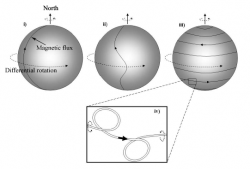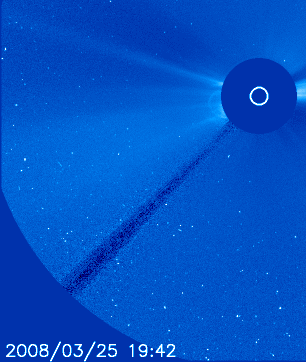As if to remind us it is still there, the Sun has put on an explosive show of sunspots, flares and coronal mass ejections (CMEs). This is quite surprising as only last month it was declared that the Sun had just started a new solar cycle, and a period of minimum activity. Up until now, the solar disk has been void of any observable features… but like an invasion party, three sunspots have rotated into view, showing complex arcs of magnetic fieldlines (coronal loops), blasting plasma into space by the biggest flare observed this year. Observers have also recorded the radio burst from the CME, so if you want to know what a CME sounds like, read on…

The Sun undergoes an 11 year cycle, beginning at “solar minimum”, culminating at “solar maximum”, and then calming down toward minimum again. At solar minimum, the Sun’s magnetic field lines, reaching from pole to pole, are at their least stressed state. As the cycle progresses, the differential rotation of the Sun (i.e. the Sun rotates quicker at its equator) drags the magnetic field lines around the solar body like an elastic band. As time goes on, the magnetic field lines become so stressed and coiled that massive loops of magnetic flux breaks through the solar photosphere (the solar “surface”). As the Sun’s atmospheric layers are hotter than the Sun’s interior (a situation known at the “coronal heating problem“), as the magnetic loops of flux appear through the photosphere, the cooler interior is exposed. When this happens, sunspots appear; the cooler interior looks darker than the surrounding photosphere, therefore creating a spot, or a “sunspot”.
If there are a lot of sunspots, the magnetic field is most stressed, and the Sun is at its most active. The magnetic flux may get so stressed that it may “reconnect” with opposite polarities, releasing huge amounts of energy as flares. Coronal mass ejections may be unleashed from these flare events, sending hot solar plasma into space. If directed at the Earth, these CMEs can cause damage to satellites, astronauts, even whole power grids on the ground. Predicting space weather (i.e. observing solar dynamics) is therefore paramount to scientists.
Interestingly, these sunspots are not from a new cycle, they are actually “left overs” from the previous cycle. Solar astronomers know this by analysing Michelson Doppler Imager (MDI) images from the Solar and Heliospheric Observatory (SOHO) currently observing the Sun. The MDI instrument has revealed that the sunspots are of the same polarity as the spots from the previous solar cycle, and not from “Solar Cycle 24“.
Yesterday, the Sun unleashed an M2-class solar flare which in-turn created a large CME, propagating away from the solar disk. The CME was not directed toward Earth. A radio astronomer in New Mexico, Thomas Ashcraft, recorded the sound coming from his 21 MHz radio telescope during the event. He heard a strange “heaving sound” as the shock wave on the leading edge of the CME generated radio waves.
Listen to the sound of the radio wave emission from a CME as it travels from the Sun.
“It was a Type II solar radio burst.” – Thomas Ashcraft, remarking on his observation of the CME.
Space weather predictions suggest there is a 50% chance of more M-class flares in the next 24 hours, so the world’s solar telescopes will be watching and waiting…
For more stunning images of the Sun by Greg Piepol (like the sunspots pictured at the top) see: http://www.sungazer.net/032508h.html
Source: spaceweather.com



I have a dream day before “solar flare”. I saw that first one will not be toward earth, but next two will be. But it is only dream, i think.
Thanks a million! The audio addition clarified so clearly how the waves come rolling in – Surf’s Up!
checked them out yesterday with my coronado,they we’re pretty sharp looking ,one had s filament coming off of it and their was beautiful filement also alongside side of the sunspot ,it was awesome,but today we’re back to clouds.
To ScepticTim:
I know, I was a little surprised about this. I’m a solar physicist and I’ve never heard of this phenomenon. It does seem to be the case of solar cylces 23 and 24 overlapping, some coiled remnants from #23 are only just being released to the surface. I haven’t found any supporting documentation on this, but on the “Space Weather” website (www.spaceweather.com) they treat it fairly routinely – apparently this is normal…
If I were to take a stab at this, although magnetic field generation inside the Sun is still difficult to understand, the #23 polarity sunspots were perhaps held under the solar surface by plasma pressure. When the Sun experienced its magnetic reversal, it perhaps injected enough energy into the “old” magnetic flux to eject it to the surface. There certainly seems to be some strange plasma dynamics going on.
I’m sure this will be approached by researchers soon, so keep an eye open for an explanation. I might do some research myself and post it on my blog, http://www.astroengine.com
Thanks for pointing this out!
Cheers, Ian 🙂
Ian: You comment that “Interestingly, these sunspots are not from a new cycle, they are actually “left overs” from the previous cycle.”
I am aware that solar cycles tend to overlap during periods of change but have not seen any convincing hypothesis explaining this overlap; do you know of a good reference? Also, I can’t help wondering if a new cycle has really begun: could no the ‘reversed polarity’ spots observed in January by simply anomalous?
To ScepticTim:
I’ve done a small article myself on the sunspots at: http://www.astroengine.net/?p=119 – it goes into some of the detail behind what is going on, but I’m not certain of the physics behind it. Hope it helps in some way though.
Cheers, Ian
Listen to that sun rawr!
After reading through the article, I just feel that I really need more information on the topic. Can you suggest some more resources ?